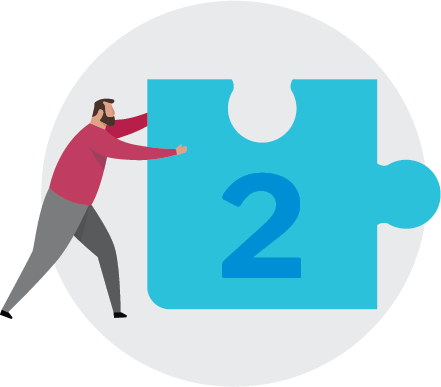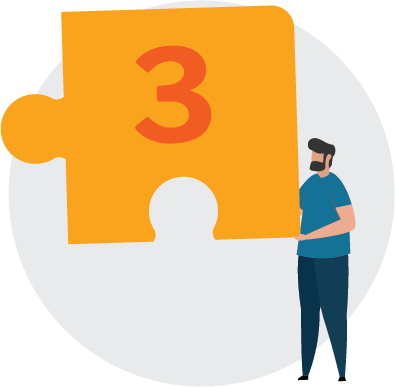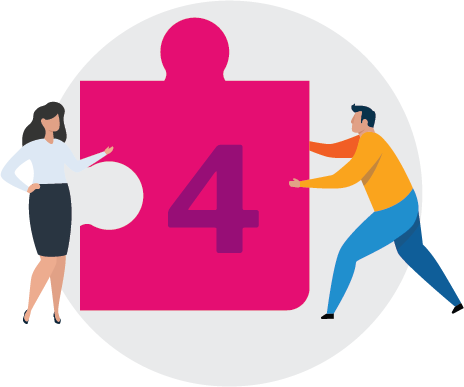If You Build It,
They Will Come
A Four-Step Plan to Match Your Learning Strategy to Your Business Strategy
According to a recent Oxford Economics survey, two-thirds of companies worldwide have made only slight or moderate progress toward meeting their strategic workplace goals. That’s a full 66% of businesses who are only sort of doing what they’ve set out to do. What’s standing in their way?
A common barrier is that the organizational capabilities don’t match business needs, and companies struggle to develop new capabilities at the speed the business requires. You can develop the most innovative products and services, build the best strategy, and hire the most talented employees. Yet, if your people aren’t connected with your vision and equipped with the skills and knowledge to make an impact, you won’t get to your desired outcome.
The numbers tell a tragic story. Less than 50% of executives say their company has a culture of continuous learning, and only 41% of employees say their organization offers them opportunities to expand their skill sets. Most employers treat training as an event to check off once a year, rather than as a foundational element, consistently reinforced, that connects people and their skills to the larger business strategy.
What’s more, learning initiatives get fragmented as different departments push out cookie-cutter siloed training. And, half of employee learning programs lack customization and follow-up. Training without the right blend of creative, engaging methodologies keeps people from emotionally and intellectually connecting to what you want them to learn.
How much discretionary energy would you put into learning something that came across as boring and uninspired? The worst part is those companies are throwing a quarter of their budget out the window* when they fail to sustain education programs after initial rollout.
So, you can start to see how enormous the problem actually is, right? Wasted time, wasted money, wasted effort.
Are you implementing a new strategy? Forging a new path?
Do you need your employees to shift their roles, change their mindset, or connect their everyday work to the bigger picture?
Bottom line: Do you want to be successful?
Learning must go beyond a mass of materials and instructions heaped upon your people in a classroom-style meeting, or dribbled out in a series of PowerPoint-turned- “eLearning” courses.
Building and maintaining a successful learning program is like building a house. First, create a blueprint of your vision. Next, choose your materials and put the structure together. Then, sustain what you’ve built with regular maintenance and reinforcement – even renovation when necessary.
Follow these four steps to get it right.

1. Envision your dream house.
Determine where you want to go. Questions to ask:
- What do you want your new house to look like?
- What are the organizational goals and training needs?
- Is it creating consistent processes across the globe, improving customer experience and satisfaction, decreasing the time to ramp up new employees, or something else?
- You’ve got to know what you want to accomplish.
Next, assess where you’re at now. Conduct a “current state analysis.”
- What do you have to work with today?
- Are there gaps in the current training path?
Observe. Talk to subject matter experts, leaders of the initiative, key thought partners, and end users. Think about the behaviors that need to be changed and the best ways to change them. Think like a learner; understand what makes them tick, what they need, what skill sets they have, and how they might like to take in the information you want to share.

In order to absorb information into long-term memory, people must be ready and willing to learn. Employees need to buy in and see the connection between what they are learning and the larger organizational vision.
2. Develop the blueprint.
Once you can picture your dream house and the materials you have to work with today, you can create the structural design for your training initiative. Create a blueprint for your program by developing performance objectives, strategic themes, and content areas for each topic in your curriculum.
The objectives must come first.
- What does the learning journey look and feel like?
- What are the emotional highs and lows?
- Do they connect back to your company strategy and objectives?
- How does training fit in with people’s other responsibilities?
Because you want concepts to build on one another, pacing, sequencing, and timing are essential. This will also help you prioritize what courses to develop and when.
Then you can customize your blueprint based on learning preferences and organizational structure. What type of blended experience is optimal for your learners?
Organizations whose people work from home, travel frequently or are geographically dispersed may need virtual training, and a centralized organization may be able to implement hands-on, in-person programs. And then, of course, you must identify how the courses tie back to performance metrics. Got all that?
This is where you might consider bringing in an architect and general contractor to help with the house plans. With so many considerations and components, an experienced strategic partner can provide guidance and executional support.
For many companies, having a partner who can build, test, produce, roll out, and sustain the program with you makes the difference between a choppy house with no flow and a sturdy house that is well-designed, safe and comfortable.


3. Build.
In order to absorb information into long-term memory, people must be ready and willing to learn. Employees need to buy in and see the connection between what they are learning and the larger organizational vision. Basically, they need to understand what’s in it for them – what does this house you’re building offer?
Develop the content. Your content must be relevant to what your employees do every single day – and it must be updateable and scalable over time. Only 62% of employees who have training available to them believe it is only somewhat or not applicable to their job.*
For example, a retailer working to improve the point of sale (POS) experience would want its frontline people practicing with actual POS tools – i.e., inputting data and completing a transaction – versus walking through generic scenarios. If the retailer is global, they may need multiple delivery methods such as hands-on sessions with local employees combined with eLearning or web sessions for employees overseas.
Determine modality. From online to social, mobile, or paper-based deliverables, each channel offers a unique texture for your house to create interest and engagement. Test it out. Start with one room. Conduct a pilot or focus group to confirm that your materials will be effective when you roll them out. Many companies skip this step, but it’s an important opportunity to refine your approach and ensure you’ve created something that will truly take hold.
As you implement your program, remember that people learn by doing, and the more we do, the better we become. Role-playing relevant scenarios will help employees transform the content they’ve been taught into meaningful action that ties to their everyday responsibilities and program goals. Providing a safe environment to practice within can help build employee confidence before they go out into the “real world.”
Ultimately, each learner should be able to answer: Why am I doing this? What’s in it for me? What’s in it for my organization? Their answers should tie back to the company’s purpose, and they should feel invigorated and connected to the vision and strategy.”

Lessons in Living the Brand
At Disney, employees are expected to know their characters inside and out, and conversations are a key “rehearsal” tool for mastery. Employees are taught the stories and details of Mickey, Goofy, Donald, and crew, and then given opportunities to role-play using dialogue with colleagues.
When they’re ready to apply their knowledge to the job, they practice in the store environment, and are observed by a manager with a checklist. This way, employees can see for themselves what delights the customer and what they can improve upon, while getting detailed and specific feedback from a coach.
4. Maintain your house and renovate when necessary.
You know you’re supposed to do it, but by the time that last course launches it’s all too easy to mark this off your to-do list. That’s because ongoing learning is not usually embedded into most organizational cultures.
Just like homes require regular maintenance, and eventually renovation, to look and function at their finest, so too will your house of learning. Adults retain less than 20 percent of learning after 90 days without reinforcement.
So, if you want the skills you’re training your people on to stick, you need a plan for fortifying and sustaining the behaviors and skills you’ve taught. This means ongoing evaluation, analysis, sustainment tools, and activities. It means providing ongoing coaching and training programs, reinforcing key behaviors and skills, and establishing metrics to measure success or identify gaps that need more work.
Make it a web application with key information, try a wiki for sharing best practices, or cook up a set of interactive games to play with colleagues. Whatever shape it takes, if you devote the time to making your follow-up and maintenance tools relevant and engaging, employees will be more likely to use them and increase their chances of success.
Most importantly, for any learning and skill building to stick, everyone from executive leadership to managers to the front line must be committed to walking the walk and talking the talk.


Curriculum Modeled After College
This sustainment process requires discipline and commitment. One successful organization in the consumer entertainment industry uses a college course structure, with 101 through 401 level courses for continued learning and best practice sharing.
At the 401 or “MBA” level, employees are nominated to be responsible for knowledge sharing in the program, becoming a source of both content and practice through shared learning with peers. The key is that employees have reference tools at their disposal and managers coach their employees to use them.
Ready to start construction?

59% of organizations don’t tailor their manager training to the areas of the business that need the most attention. And only 18% of companies strongly feel they’ve been successful at sustainment so far.** It’s hard work. Really hard work. That’s why many organizations can use a hand when it comes to curriculum design, development, and sustainment, even when they have the resources and tools in house.
Let’s face it:
- Training must be tightly connected to your organization’s overall strategy, or the strategy will fall short.
- Your people may not have enough bandwidth to cover their responsibilities plus time-intensive curriculum planning and execution.
- Your internal team may be too entrenched to objectively understand your learners’ strengths and weaknesses and see things through their eyes.
As you embark on your new strategy and build your people up with the knowledge and tools they need to help you succeed, grab the right partners to help you:
- Develop your vision for a new house of learning.
- Create the blueprint for learning, mapping out the architecture to get from your current state to realizing your dream.
- Build your house with sturdy materials that are relevant to what your people do every day.
- Reinforce and renovate skills continually with sustainment tools and activities, so it sticks for the long haul.
How will you know if you are successful? With a strong curriculum, you’ll see a rise in achieving your targeted business outcomes. You will also see your people are happier and more fulfilled, taking greater pride in their work every day. It’s true: Build it, and they will come. Construct with their interests and success in mind. Teach them in the way they want to learn. Engage them. And remember, the actual training is just the beginning in a great house of learning.
Sources
*Root/Kelton Group Manager Survey, Dec. 2014
**Root/Kelton Group Manager Sustainment Survey, Jan. 2015







